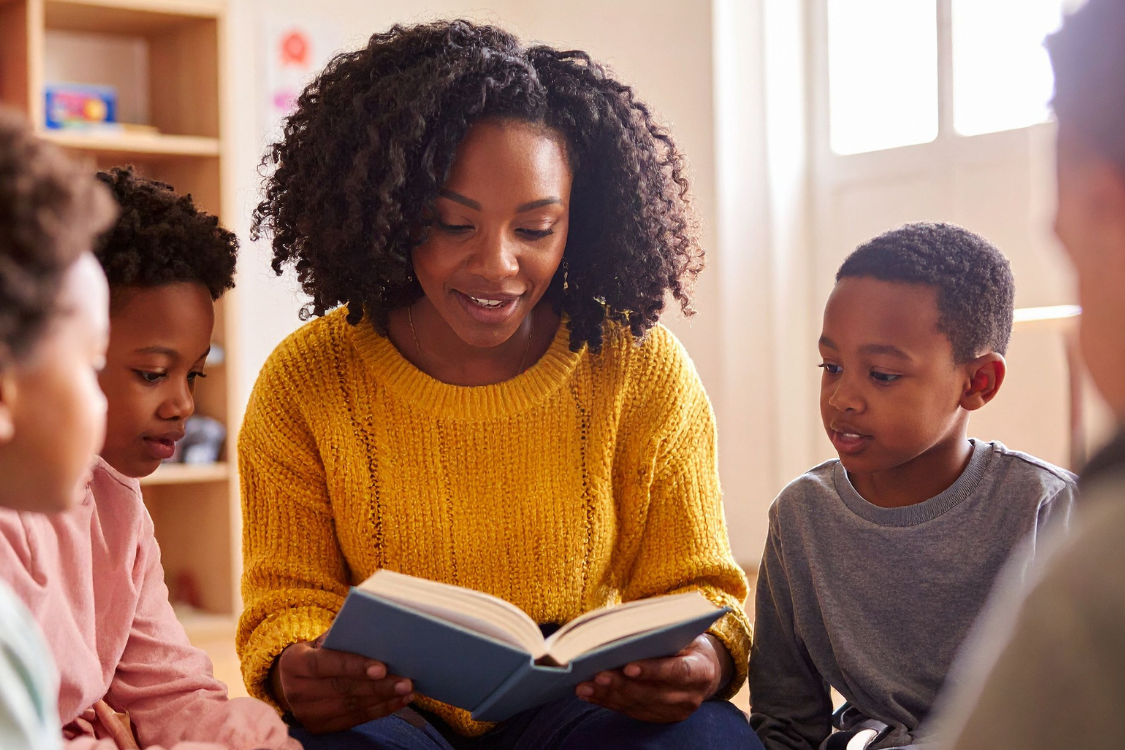You’re snuggled up with your little one, reading their favorite picture book for the hundredth time. Instead of just reading the words on the page, you pause and ask, “What do you think will happen next?” or “Can you find something blue on this page?” Suddenly, your child leans in, points excitedly, and chatters about the story. You’ve just experienced dialogic reading – and you’ve transformed a simple bedtime routine into a powerful learning experience that builds the foundation for reading success.
What Is Dialogic Reading and Why Does It Matter?
Dialogic reading is an interactive approach to sharing books where the adult and child engage in meaningful conversations about the story, pictures, and ideas in the book. Rather than the traditional model where adults read TO children, dialogic reading encourages children to become active participants who talk WITH adults about books.
A landmark study found that children who participated in dialogic reading sessions showed significant improvements in expressive language skills compared to children who experienced traditional story reading. The children in the dialogic reading group demonstrated vocabulary growth that was 8.5 months ahead of their chronological age, while the control group showed typical development.
The power of dialogic reading lies in its ability to transform passive listening into active engagement. When children respond to questions, make predictions, and share their thoughts about stories, they’re practicing essential pre-reading skills. They’re learning that books contain ideas worth discussing, that their thoughts and observations matter, and that reading is inherently an interactive and meaningful experience.
Dr. Grover Whitehurst, who developed the dialogic reading approach, found that this method is effective because it follows natural patterns of language learning. Children learn language best through back-and-forth conversations where they receive immediate feedback and encouragement. Dialogic reading creates countless opportunities for these meaningful exchanges within the context of engaging stories.
The PEER Method: Your Simple Framework for Success
The beauty of dialogic reading lies in its simplicity. You don’t need special training or expensive materials – just the willingness to have conversations about books. The PEER method provides an easy-to-remember framework for getting started:
Prompt: Ask questions or make requests that encourage your child to talk about the book. These might include “What’s happening in this picture?” or “Tell me about this character.”
Evaluate: Listen to your child’s response and provide feedback. This doesn’t mean judging whether they’re “right” or “wrong,” but rather acknowledging their contribution and gently expanding on it.
Expand: Add information to what your child has said, introducing new vocabulary or concepts naturally. If your child says “dog,” you might respond with “Yes, that’s a big, fluffy golden retriever!”
Repeat: Give your child another chance to use the new information you’ve provided, reinforcing their learning through repetition and practice.
This framework works because it mirrors the natural way children learn language through conversation. The PEER method also adapts beautifully to your child’s developmental stage. With toddlers, prompts might be as simple as “What’s that?” while preschoolers can handle more complex questions like “Why do you think the character made that choice?” The key is following your child’s lead and building on their interests and observations.
Age-Appropriate Techniques That Grow With Your Child
Dialogic reading techniques naturally evolve as children develop, making this approach valuable from infancy through the elementary years. For babies and toddlers (ages 0-2), focus on labeling and describing. Point to pictures and name objects, colors, and actions. Ask simple questions like “Where’s the kitty?” and celebrate when they point or attempt to say the word. This early interaction builds foundational language skills and positive associations with books.
Preschoolers (ages 3-5) are ready for more complex interactions. Encourage them to tell you what’s happening in pictures, make predictions about story outcomes, and relate book events to their own experiences. Ask open-ended questions like “What would you do if you were this character?” or “This reminds me of when we went to the zoo – what do you remember about that day?” These conversations build comprehension skills while expanding vocabulary and background knowledge.
For early elementary students (ages 5-8), dialogic reading can include discussions about character motivations, story structure, and connections between different books. Encourage critical thinking with questions like “What do you think the author wants us to learn from this story?” or “How is this book similar to another book we’ve read?”
Make Every Book a Learning Adventure
One of the most appealing aspects of dialogic reading is its flexibility – virtually any book can become an opportunity for rich conversation and learning. Picture books naturally lend themselves to discussion about illustrations, characters, and plot development. Non-fiction books offer opportunities to explore new concepts, make connections to children’s experiences, and ask investigative questions.
The key is approaching each book with curiosity and enthusiasm. Before opening a book, take a moment to examine the cover together. Ask your child what they think the story might be about based on the title and illustration. This simple practice, called “picture walking,” builds prediction skills and activates prior knowledge – both important comprehension strategies.
During reading, pause frequently to discuss what’s happening. Don’t feel pressure to finish the entire book in one sitting if rich conversations emerge. Some of the most valuable learning happens when children have time to process and respond to story elements.
After reading, extend the conversation by connecting the book to your child’s life, other books you’ve shared, or upcoming experiences. These connections help children organize their learning and see reading as relevant to their world. Ask questions like “Does this character remind you of anyone we know?” or “What would happen if we tried this at home?”
Transform Your Storytime Starting Tonight
The remarkable thing about dialogic reading is that you can begin implementing it immediately with whatever books you have at home. Start with just one or two simple questions during your regular reading time, and gradually incorporate more conversation as both you and your child become comfortable with the interactive approach. Remember that the goal isn’t to quiz your child or turn every book into a lesson, but rather to share the joy of discovering ideas together through stories.
Ready to transform your family’s reading time into powerful learning conversations? Start your free 7-day trial with Reading.com today and discover how our interactive approach builds on the same principles that make dialogic reading so effective. Our app guides you through engaging activities that turn every reading session into an opportunity for meaningful dialogue and skill building. Begin your family’s enhanced reading adventure tonight.





